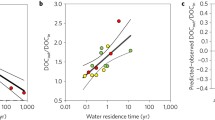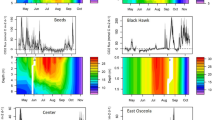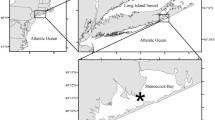Abstract
Recent, parallel developments in the study of freshwater and marine ecosystems have provided evidence that net heterotrophic systems (those in which respiratory organic matter destruction exeeds photosynthetic production) are more prevalent than hitherto believed, including most rivers, oligo- to mesotrophic lakes and some oligotrophic regions of the ocean. In parallel, these aquatic ecosystems have been shown to act as CO2 sources to the atmosphere, as expected from the heterotrophic nature of the communities they contain. The prevalence of net heterotrophic aquatic ecosystems indicates that they must receive significant inputs of organic carbon from adjacent ecosystems, assigning an important role to the lateral exchanges of carbon between land and aquatic ecosystems, between coastal and open ocean ecosystems, as well as internal redistribution within large or complex aquatic ecosystems in determining their metabolic status and the gaseous exchange with the atmosphere. The examination of the carbon budget of ecosystems requires, therefore, an integrative approach that accounts for exchanges between compartments often studied in isolation. These recent findings conform a new paradigm of the functioning of aquatic ecosystems, and the metabolic connectivity between ecosystems in the biosphere.


Similar content being viewed by others
References
Agustí S, Duarte CM, Vaqué D, Hein M, Gasol JM, Vidal M. 2001. Food web structure and elemental (C, N, and P) fluxes in the Eastern tropical North Atlantic. Deep-Sea Research II 48:22952–321
Agustí S, Satta MP, Mura MP. 2004. Summer community respiration and pelagic metabolism in upper surface Antarctic waters. Aquat Microb Ecol 35:197–205
Aitkenhead JA, McDowell WH. 2000. Soil C:N ratio as a predictor of annual riverine DOC flux at local and global scales. Global Biogeochem. Cycles 14:1271–38
Arístegui J, Harrison WG. 2002. Decoupling of primary production and community respiration in the ocean: implications for regional carbon studies. Aquat Microb Ecol 29:1992–09
Bauer JE, Druffel ERM. 1998. Ocean margins as a significant source of organic matter to the deep open ocean. Nature 392:4824–5
Bertilsson S, Tranvik LJ. 2000. Photochemical transformation of dissolved organic matter in lakes. Limnol Oceanogr 45:7537–62
Caffrey JM. 2004. Factors controlling net ecosystem metabolism in U.S. Estuaries. Estuaries 27:901–101
Caraco NF, Cole JJ. 2004. When terrestrial organic matter is sent down the river: Importance of allochthonous C inputs to the metabolism in lakes and rivers. In: Polis A, Power ME, Huxel GR (eds). Food webs at the landscape level. University of Chicago Press, pp 301–16
Carignan R, Planas D, Vis C. 2000. Planktonic production and respiration in oligotrophic Shield lakes. Limnol Oceanogr 45:189–99
Chen C-C, Shiah F-K, Gong GC, Chiang K-P. 2003. Planktonic community respiration in the East China Sea: importance of microbial consumption of organic carbon. Deep-Sea Res. II 50:13111–25
Cole JJ, Caraco NF, Kilng GW, Kratz TK. 1994. Carbon dioxide supersaturation in the surface waters of lakes. Science 265:15681–70
Cole JJ, Caraco NF. 2001. Carbon in catchments: connecting terrestrial carbon losses with aquatic metabolism. Mar Freshwater Res 52:1011–10
Cole JJ, Pace ML, Carpenter SR, Kitchell JF. (2000) Persistence of net heterotrophy in lakes during nutrient addition and food web manipulations. Limnol Oceanogr 45:17181–30
Cole JJ. 1999. Aquatic microbiology for ecosystem scientists: new and recycled paradigms in ecological microbiology. Ecosystems 2:2152–25
del Giorgio PA, Cole JJ, Cimbleris A. 1997. Respiration rates in bacteria exceed plankton production in unproductive aquatic systems. Nature 385:1481–51
del Giorgio PA, Duarte CM. 2002. Respiration in the open ocean. Nature 420:3793–84
del Giorgio PA, Peters RH. 1994. Patterns in planktonic P:R ratios in lakes: Influence of lake trophy and dissolved organic carbon. Limnol Oceanogr 39:772–87
del Giorgio PA, Williams PjleB. The global significance of respiration in aquatic ecosystems: from single cells to the biosphere. In: del Giorgio PA, Williams PJleB, Eds. Respiration in aquatic ecosystems, Oxford University Press. [in press-a]
del Giorgio PA, Williams PjleB. Respiration in aquatic ecosystems, Oxford University Press [in press-b]
Dillon PJ, Molot LA. 1997. Dissolved organic and inorganic carbon mass balances in central Ontario lakes. Biogeochem 36:29–42
Duarte CM, Agustí S, del Giorgio PA, Cole JJ. 1999. Regional carbon imbalances in the oceans. Science 284:1735b
Duarte CM, Agustí S. 1998. The CO2 balance of unproductive aquatic ecosystems. Science 281:234–6
Duarte CM, Arístegui J, González N, Agustí S, Anadón R. 2001. Evidence for a heterotrophic subtropical NE Atlantic. Limnol Oceanogr 46:4254–8
Duarte CM, Cebrián J. 1996. The fate of marine autotrophic production. Limnol Oceanogr 41:1758–66
Duarte CM, Agustí S, Vaqué D. 2004. Controls on planktonic metabolism in the Bay of Blanes, north-western Mediterranean litoral. Limnol Oceanogr [in press]
Ducklow HW, McCallister SL. The biogeochemistry of carbon dioxide in the coastal oceans, In: Robinson AR, Brink K, Eds. The sea, vol 13, The global coastal ocean-multi-scale interdisciplinary processes. Harvard Univ. Press [in press]
Field CB, Behrenfeld MJ, Randerson JT, Falkowski P. 1998. Primary production of the biosphere: integrating terrestrial and oceanic components. Science 281:2372–40
Frankignoulle M, Abril G, Borges A, Bourge I, Canon C, Delille B, Libert E, Théate JM. 1998. Carbon dioxide emisión from European estuaries. Science 282:434–8
Gattuso J-P, Franjignoulle M, Wollast R. 1998. Carbon and carbonate metabolism in coastal aquatic ecosystems. Annu Rev Ecol Syst. 29:405–33
González N, Anadón R, Mouriño B, Fernández E, Sinha B, Escánez J, de Armas D. 2001. The metabolic balance of the planktonic community at the N. Atlantic Subtropiucal Gyre: the role of mesoscale instabilities. Limnol Oceanogr 46:946–52
Hansell DA, Ducklow HW, Macdonald AM, O’Neil Baringer M. 2004. Metabolic poise in the North Atlantic Ocean diagnosed from organic matter transports. Limnol Oceanogr 49:1084–94
Hanson PC, Bade DL, Carpenter SR, Kratz TK. 2003. Lake metabolism: relationships with dissolved organic carbon and phosphorus. Limnol Oceanogr 48:11121–9
Harrison WG, Arístegui J, Head EJH, Li WKW, Longhurst AR, Sameoto DD. 2001. Basin-scale variability in plankton biomass and community metabolism in the subtropical North Atlantic Ocean. Deep-Sea Res II 48:2241–69
Hemminga MA, Duartey CM. 2000. Seagrass ecology. Cambridge Univ. Press, Cambridge
Hope D, Kratz TK, Riera JL. 1994. Relationship between pCO2 and dissolved organic carbon in northern Wisconsin lakes. J Environ Qual 25:14421–5
Hopkinson CS Jr., Smith EM. Estuarine respiration: An overview of benthic, pelagic, and whole system respiration. In: del Giorgio PA, Williams PJleB, Eds. Respiration in aquatic ecosystem. Oxford Univ. Press, NY, USA. [in press]
Hoppe H-G, Gocke K, Koppe R, Begler C. 2002. Bacterial growth and primary production along a north-south transect in the Atlantic Ocean. Nature 416:168–71
Houghton RA. 2003. Why are estimates of the terrestrial carbon balance so different?. Global Change Biol. 9:5005–9
IPCC. 2001 The carbon cycle and atmospheric carbon dioxide. In: IPCC, Climate Change 2001. Cambridge Univ. In Press, Cambridge, pp 183–237
Karl DM, Laws EA, Morris P, Williams PleBJ, Emerson S. 2003. Metabolic balance of the open sea. Nature 426:32
Kling GW, Kipphut GW, Miller MC. 1991. Arctic lakes and streams as gas conduits to the atmosphere – Implications for tundra carbon budgets. Science 251:298–301
Knauer GA. 1993. In: Wollast R Eds. Interactions of C, N, P, and S biogeochemical cycles and global change. Berlin: Springer-Verlag, p 211–31
Liu JK, Atkinson L, Chen CTA, Gao S, Hall J, Macdonald RW, Talaue-McManus L, Quiñones R. 2000. Exploring continental margin carbon fluxes on a global scale. EOS 81:641–4
Liu J-K, Iseki K, Chao S-Y. 2002. Continental margin carbon fluxes. In: Hanson RB, Ducklow HW, Field JG (eds). The changing ocean carbon cycle. Cambridge Univ. Press, London, pp 186–239
Lucea A, Duarte CM, Agustí S, Kennedy H. Nutrient dynamics and ecosystem metabolism in the Bay of Blanes (NW Mediterranean). Biogeochemistry. [in press]
Ludwig W, Probst JL, Kempe S. 1996. Predicting the oceanic input of organic carbon by continental erosion. Global Biogeochemical Cycles 10:23–41
Mulholland PJ. 2003. Large-scale patterns in dissolved organic carbon concentration, flux, and sources, In: Stuart EG, Findlay G, Sinsabaugh RL (eds). Aquatic ecosystems: interactivity of dissolved organic matter. Elsevier Science, Amsterdam, p. 512
Odum HT. 1956. Primary production in flowing waters. Limnol Oceanogr 1:112–7
Pace ML, Cole JJ, Carpenter SR, Hodgon JR. 2004. Whole-lake carbon-13 additions reveal terrestrial support of aquatic food webs. Nature 423:240–3
Pace ML, Prairie YT. Respiration in lakes. In: del Giorgio PA, Williams PJLeB, Eds. Respiration in aquatic systems Oxford University Press, NY, USA. [in press]
Prairie YT, Bird DF, Cole JJ. 2002. The summer metabolic balance in the epilimnion of southeastern Quebec lakes. Limnol Oceanogr 47:316–21
Raymond PA, Bauer JE, Cole JJ. 2000. Atmospheric CO2 evasion, dissolved inorganic carbon production, and net heterotrophy in the york river estuary. Limnol Oceanogr 45:1707–17
Raymond PA, Cole JJ. 2003. Increase in the export of alkalinity from North America’s largest river. Science 301:88–91
Richey JE, Melack JM, Aufdenkampe AK, Ballester VM, Hess LL. 2002. Outgassing from Amazonian rivers and wetlands as a large tropical source of atmospheric CO2. Nature 416:6176–20
Robinson C, Williams, PJleB. Respiration and its measurement in surface waters. In: del Giorgio PA, Williams PJleB, Eds. Respiration in aquatic ecosystem. Oxford Univ. Press, NY, USA. [in press]
Sabine CL, Feely RA, Gruber N, Key RM, Lee K, Bullister JL, Wanninkhof R, Wong CS, Wallace DWR, Tilbrook B, Millero FJ, Peng T-H, Kozyr A, Ono T, Rios AF. 2004. The oceanic sink for Anthropogenic CO2. Science 305:367–71
Schelsinger WJ, Melack JM. 1981. Transport of organic carbon in the world’s rivers. Tellus 33:172–87
Schlesinger WH. 1991. Biogeochemistry. An analysis of global change: Academic Press, New york
Scully NM, Cooper WJ, Tranvik LJ. 2003. Photochemical effects on microbial activity in natural waters: the interaction of reactive oxygen species and dissolved organic matter. Fems Microb Ecol 46:353–7
Serret P, Robinson C, Fernández E, Teira E, Tilstone G. 2001. Latitudinal variation of the balance between plankton photosynthesis and respiration in the eastern Atlantic Ocean. Limnol Oceanogr 46:1642–52
Smith S, MacKenzie F. 1987. The ocean as a heterotrophic system: implications for the global carbon cycle. Global Biogeochem Cycles 1, 187–98
Smith SV, Hollibaugh JT. 1993. Coastal metabolism and the oceanic organic carbon balance. Rev Geophysics 3:75–89
Takahashi T, Sutherland SC, Sweeney C, Poisson A, Metzl N, Tilbrook B, Bates N, Wanninkhof R, Feely RA, Sabine C, Olaffson J, Nojiri Y. 2002. Global sea–air CO2 flux based on climatological surface ocean pCO2, and seasonal biological and temperature effects. Deep-Sea Res. II 49:1601–22
Vanni MJ, DeAngelis DL, Schindler DE, Huxel GR. 2004. Overview: cross-habitat flux of nutrients and detritus. In: Polis A, Power ME, Huxel GR (eds). Food webs at the landscape level. University of Chicago Press, Chicago, USA, pp 3–11
Watson AJ, Orr JC. 2003. Carbon dioxide fluxes in the global ocean. In: Fasham MJR, Ed. Ocean biogeochemistry, Berlin: Springer-Verlag, pp 123–43
Webster JR, Meyer JL. 1999. Organic matter budgets for streams: a synthesis. J North Amer Benthol Soc 16:141–61
Williams PJleB. 2000. Net production, gross production and respiration: what are the interconnections and what controls what? In: Hanson RB, Ducklow HW, Field JG (eds). The changing ocean carbon cycle. Cambridge Univ. Press, London, pp 37–60
Williams PJLeB. 1998. The balance of plankton respiration and photosynthesis in the open ocean. Nature 394:55–7
Williams PleBJ, Bower DG. 1999. Determination of organic carbon balance in the oceans from field observations - A re-evaluation. Science 284:1735a
Acknowledgements
This research is a contribution to projects EUROTROPH, funded by the European Commission (project EUROTROPH, ref. REN2001-4977-E), COCA (REN-2000-1471-C02), funded by the Spanish I+D program, and the “Integrating the aquatic with the terrestrial component of the global carbon budget” Working Group, supported by the National Center for Ecological Analysis and Synthesis, a Center supported by NSF (Grant #DEB-94-21535), the University of California at Santa Barbara, and the State of California. Y.P. and C.M.D. were also supported by sabbatical fellowships from the Spanish Ministry of Education and Science. We thank J.J. Cole and three anonymous reviewers for helpful suggestions.
Author information
Authors and Affiliations
Corresponding author
Rights and permissions
About this article
Cite this article
Duarte, C.M., Prairie, Y.T. Prevalence of Heterotrophy and Atmospheric CO2 Emissions from Aquatic Ecosystems. Ecosystems 8, 862–870 (2005). https://doi.org/10.1007/s10021-005-0177-4
Received:
Accepted:
Published:
Issue Date:
DOI: https://doi.org/10.1007/s10021-005-0177-4




